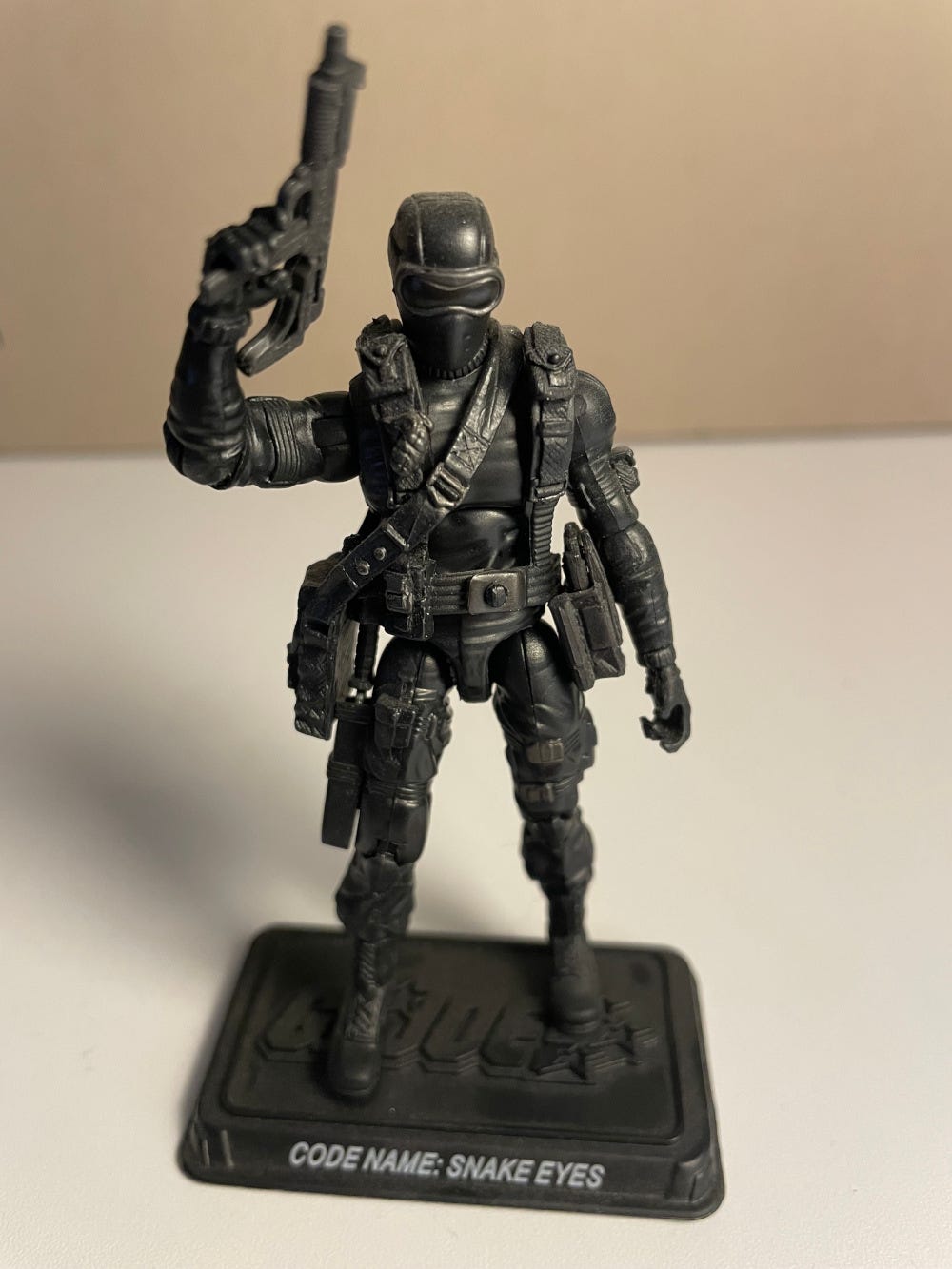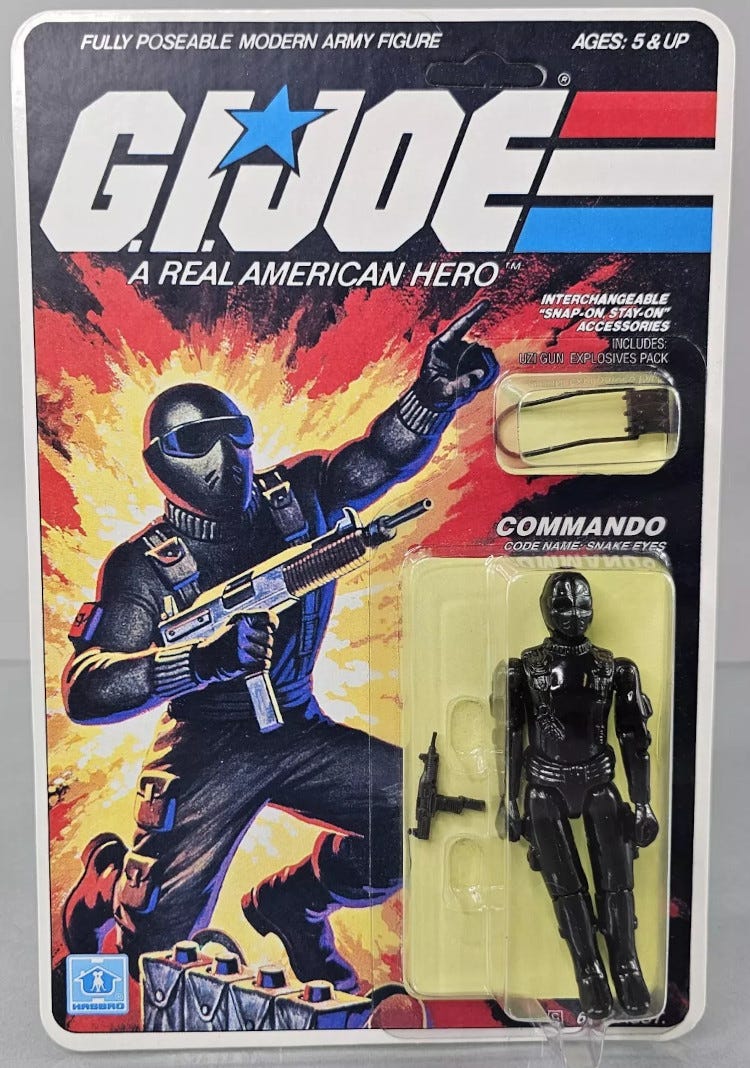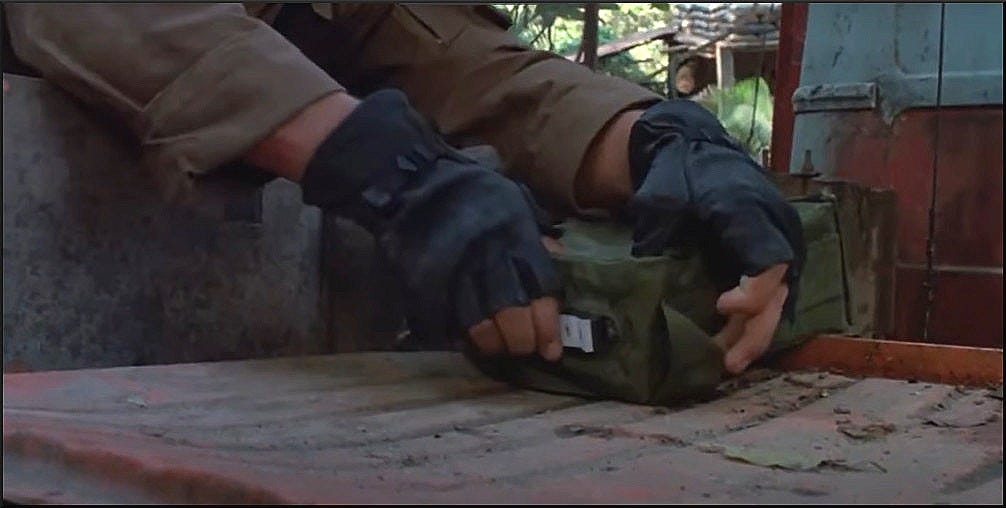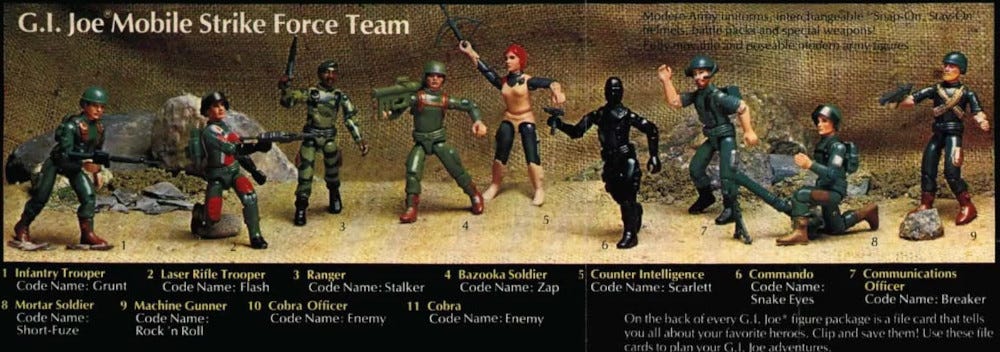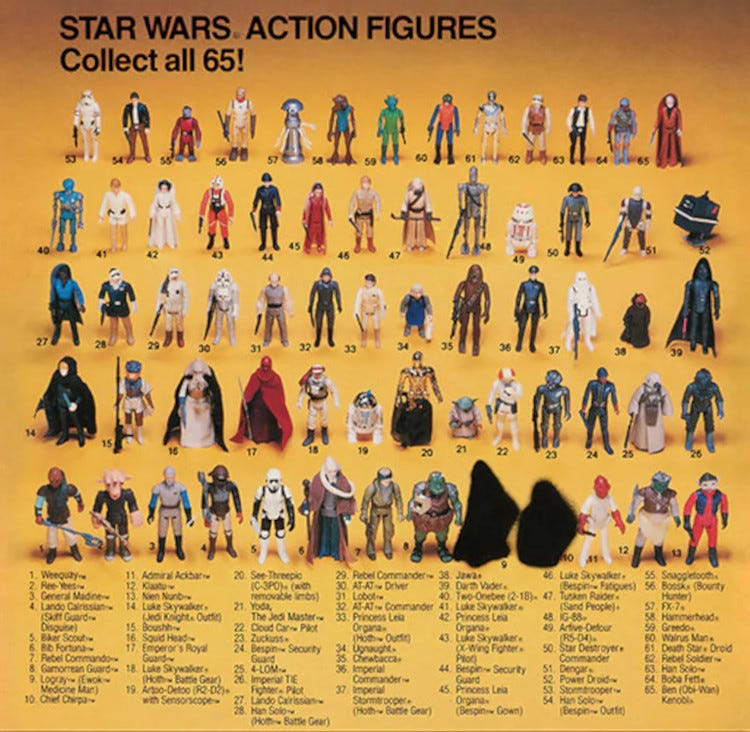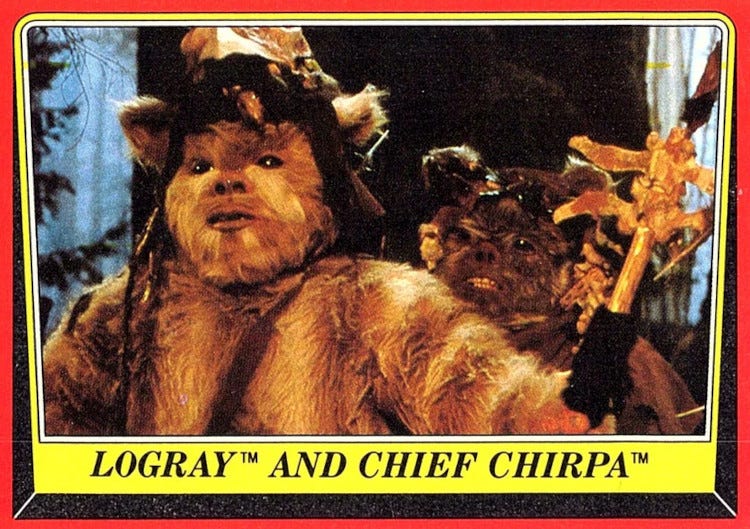Snake Eyes
Let’s start with the action figure that kicked off a lifelong hobby (read: obsession).
I was raised an Army brat. So when it came to G.I. Joe, I saw soldiers dressed like them every day on Fort Sheridan Army base where I grew up… well, sans live weaponry. Most of the figures in that initial 1982 line-up looked very much like traditional soldiers (whether Grunt in olive drab fatigues, Stalker in jungle camouflage).
Nevertheless, it was Snake Eyes who first drew me into the brand…
This figure’s history and development are famously known. Part of the first wave for G.I. Joe’s 1982 relaunch, Snake Eyes was kept all black in order to save on paint steps, and with a masked cowl to help save on face detailing. (Snake Eyes already making sacrifices for the team; his lack of added paint steps allowed Hasbro to keep those in place for the other figures.) And yet it was precisely these cost-saving measures that ended up drawing me—and countless other kids—to draft him first off the shelves.
Granted, part of this can be attributed to his vibrant card art. While the figure itself may have seemed relatively “blank”, his illustration (by artist Hector Garrido) depicted exactly who he was—a masked and mysterious commando, gun at the ready in the midst of some explosion-backed engagement.
(To be fair, all figures may have been back lit with that same explosion, but which made every single one of them that much more exciting.)
I didn’t know a thing about this figure. I didn’t even understand him, exactly. “Commando” didn’t mean anything specific to me (as “a soldier specializing in hit-and-run raids”) apart of being a generally bad-ass looking figure. Commando, Arnold Schwarzenegger’s film wouldn’t come out until 1985, and The Dirty Dozen (featuring Army commandos) had been back in 1967.
And while I could see that Snake Eyes had a gun, I wasn’t sure what that little black satchel he also came with was supposed to be (once you opened the figure’s packaging bubble, the printed description for his “explosives pack” invariably ripped away). Was that like a school bag or a purse of some kind? I don’t think I ever got it until I saw a satchel charge used in 1987’s Predator (Arnold again, who factored into my childhood as much as G.I. Joe).
Well, Arnold, G.I. Joe, and Star Wars…
From Star Wars to G.I. Joe
Return of the Jedi hit the screen in 1983, forever answering the question—how much more marketable would Wookies be if they looked exactly like living teddy bears? As it turns out, a lot. But it was around this time that the 80’s bike-riding kids on my block were already transitioning to the next big craze, and I was powerless to resist the peer pressure and market research expertise of friends one grade older than me.
Star Wars may have firmly established the dominance of 3 3/4” (or 1/18th scale) action figures, but here came G.I. Joe with more points of articulation, more accessories, and while it might not have had the backing of the highest grossing film of 1983, it did have its own transmedia campaign with a tie-in Marvel comic (issue #1 hitting June 1982) and animated series (starting with the The M.A.S.S. Device mini-series in September ‘83).
My friends and I (shout-out to Jeff and Steve) were all in.
“Which one’s G.I. Joe?” I asked, looking through whatever little catalog booklet one of them was showing off. For whatever reason, I couldn’t grasp the concept of a team name and believed one of them had to be “Joe”. Which one was the main character, the hero? Which one was the Luke Skywalker?
“They all are,” just didn’t make sense at the time. Maybe my brain was already melting down at the glorious display of all these new figures to collect.
Somewhere down my street (which no longer even exists, now absorbed into the Fort Sheridan Forest Preserve) I’m sure my mother could hear the ominous, phantom sounds of a cash register ringing up sales at Toys “R” Us.
“Don’t you already have enough Star Wars guys?” I’m sure she asked me.
I did, actually. But mentally, I had already moved on to this new brand. I never even got around to finishing my Return of the Jedi collection, ironically forgoing the final two figures I needed. And the most mysterious ones—prior to the film’s release, the back of the other figures arriving in toy stores had these two characters blacked out.
Who were they?
Chief Chirpa and Logray, the Medicine Man.
That’s right, the Ewoks.
Maybe Star Wars now meant teddy bears to me, and G.I. Joe meant cool Army soldiers. A more “serious” action figure for us older, more erudite and sophisticated collectors. In fact I can’t even remember any mixed play battles between the two brands. I brought Snake Eyes home and stubbornly played with him on his own until more G.I. Joe figures could be wrangled to join the fight.
So out of the all the Joes, I chose the one who seemed like a figure that was somehow kept blacked out. I suppose he struck me as far more compelling than what those two figures obscured on the Star Wars card backs actually turned out to be.
The Mysterious Man in Black as a Character
One of the many reasons for covering G.I. Joe, aside from once more lovingly considering all these figures deployed along my office shelves, is to explore how they can be further used in writing—world and character-building, both in fiction as well as in TRPGs. In addition to collecting action figures as a lifelong hobby, I’ve also been writing—personally as well as professionally for the tabletop and video game industries for the past 20+ years.
What better excuse to marry these two together?
And just look at Snake Eyes. Even as a “mere” phantom blot, he still has numerous characteristics to pick apart:
The mysterious stranger
The unbeatable warrior
The silent partner
The beast master
Next time, we’ll take one of these angles and see how it might help inform other writing projects.
Final Thoughts…
For as much money sunk into Toys “R” Us, I remember my dad taking me to a KB Toys instead. It was 1983, and I sadly made the mistake of choosing a 1982 version of Snake Eyes without the new “Swivel Arm Battle Grip”. Oh well.
To see the best possible images of Snake Eyes (and really, of all figures in the brand), check out 3DJoes.com.
And for a tour through variations of the figures through the years, YoJoe.com remains a tremendous resource.
Random trivia: As noted in the brand guidelines for Kindle Worlds (a platform for publishing fan fiction that ran from 2012-2018), “Snake Eyes shall never be depicted or described as a fan of the New York Yankees.”




